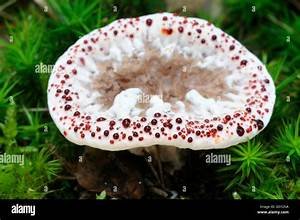Bleeding Hydrellum (Bleeding Tooth Fungus)
+
Bleeding Hydrellum (Bleeding Tooth Fungus
Recently, on a guided tout at Springwanre Park North od Barrie, Ontario we came upon the a dozen or so mushrooms under some coniferous trees.
I had never seen mushroom that looked so unusual and wanted to learn more.
Below is what I doscovered about this ver unusual fungus.
The adult mushroom is beige and rather dull in appearance.
When young and actively growing, however, this whitish
mushroom appears to bleed from its pores, inspiring some of
its colourful names including Devil’s Tooth.
Bleeding Hydrellium is found in forested regions, not only in
North America but also Iran, South Korea, and Europe.
This gooey red liquid is actually a sap of sorts caused by a
process called guttation.
When the soil surrounding the fungus' root system becomes very wet, it may force water into the roots through the process of osmosis. This creates pressure throughout the organism, which eventually builds up enough to force liquid to the surface of the fungus.
The Bleeding Tooth Fungus is not toxic, but tastes so bitter as to be inedible, despite one of its other names like Strawberries and Cream.
BENEFITS
Bleeding Tooth Fungus has a symbiotic relationship with the coniferous trees among whose roots it is located.
The trees provide the fungus with access to a fixed source of carbon dioxide.
The fungus produces enzymes that convert amino acids and minerals found in the soil into forms that the host trees can better use.
The fungi's presence is indicative of an old, species-rich forest, and scientists express concern when it disappears from an area, as seems to be happening in areas of Europe, where nitrogen deposits caused by pollution may be a problem.
It is amorphous.
This characteristic can find it growing around other organic items such as dropped branches and eventually engulfing the object.
One of the main uses for the fungus is as a dried specimen.
Dried fungi are made into beige dye for textiles and cordage.
When combined with certain other substances, such as alum or iron, the fungi tones change to hues tinged with blue or green
Scientists have found that extracts from the Bleeding Tooth Fungus contain the chemical compound atromentin, which acts like heparin to get rid of blood clots.
It also has anti-bacterial properties and may be an option for treating the most common strain of bacterial pneumonia.
Researchers are also looking at another chemical found called thelephoric acid, which may someday be used to treat Alzheimer's disease.
.






Comments
Post a Comment